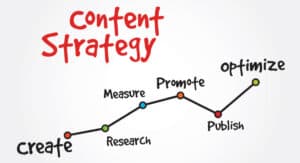Are you struggling to post consistently and think of exciting content that’s different from your competitors? Have you ever thought of using a content calendar?
Whether you’re a new business or just hoping for better results from your current strategy for content marketing – we’ve got you covered!
Content creation doesn’t have to be a difficult process; however, it does have to be consistent and valuable to your audience. Your content calendar can be as simple or complex as your business/brand needs it to be.
If you’re wanting to step-up your content marketing game, keep reading and we will give you all the tips and tricks to building an effective content calendar for your brand.
Don’t have time to create an effective content plan yourself? Contact us and our expert team will help you with all your digital marketing needs!
Importance of creating an effective content calendar
You wouldn’t start a company without a mission statement or plan, so why would you create content without a plan? There are many benefits to having a great content plan, such as:
- It saves you time by planning ahead;
- Keeps you on schedule by posting consistently;
- Allows you to plan and prevent making mistakes or spelling errors;
- Maintains a consistent message and voice across all digital marketing campaigns; and
- Ensures that content aligns with your overall strategy.
So, you may be thinking, “how do I get started?” Keep reading to find out the best steps to creating an effective content calendar.
How to get started on your content calendar:
-
Set Goals
Before you begin creating content and calendars, it is important to understand what areas you need to focus on and what your goals are. Your goals could range from:
- Attracting more visitors to your website;
- Generate more leads; or
- Grow a larger, organic following on social media, etc.
Once you understand what areas need improvement, it will be easier to get an idea of what platforms will work best and what content should perform well for your brand.
-
Platform Audit
It is important to remember that content needs to be tailored for each platform and its unique audience. So, you want to make sure that you look at each channel and see how well they’re performing. Here are some key factors to consider:
- What platforms are you currently using?
- Which platforms are performing best?
- Should you continue to publishing to all of them?
- How frequently are you posting to each platform?
- What are your goals for each platform?
Once you have completed this audit, you should have a clear understanding of what platforms need most attention and what improvements need to be made.
-
Choose your channels
Creating content for social media can definitely be time consuming. But it is well worth your time if you know which platforms work best for you. To ensure you’re making the most of your time, you should take a minute to ensure you are using the correct platforms for your business. If you’re not sure how to assess the performance in your social media platforms, check out our free social media checklist.
Focus on fewer channels and excel in them
Remember, it is better to focus on fewer channels and excel in them. Otherwise, you might run the risk of utilising too many channels and not gaining optimal performance and interaction from your audience.
Here are some of our favourites:
- Google My Business
- Website – Blog posts
To learn more about the basics of social media, revisit our blog about social media FAQs or contact us to start your company’s social media content marketing.
-
Establish post frequency
Now that you’ve gathered all possible information, it’s time to start establishing a workflow. Here are some important factors to consider:
- How often do you want to post to each channel;
- What is the best time to post to each channel? (Take a look at previous post analytics); and
- What will your content ratio look like?
Once you have an idea about frequency, the next step is to start planning!
-
Create a content calendar template
Start with a basic skeleton
The best thing about creating your own template, is that you can customise it specifically for your brand. However, we advise that you begin with the basic details:
- Platform
- Date
- Time
- Post theme (e.g. customer testimonial, selling post)
- Post Copy (e.g. caption)
- Visuals (e.g. photo, video, illustration, infographic, gif, blog, etc.)
Once you have the basics, you can easily make changes as you start adding content to your calendar.
Allow enough space for changes
- As you become more familiar with creating content, you may have to make some changes. Ensure you allow space for improvements and minor changes.
Colour code each category
- Another tip to ensure your content calendar is legible, try colour coding different categories.
Marketing is impossible without great content. Read more about the importance of quality content.
-
Utilise a real calendar as a reference point
When you’re filling out your content calendar, have a regular calendar on hand to use as a reference that highlights key dates, seasons, holidays and events that may have relevance to your business. Building your content around these dates, will help with filling in gaps in your content calendar.
-
Plan your content
Once holidays, seasons and events have been marked down, start to fill in the blanks with content that is relevant to your brand. This content can include:
- Blog posts;
- Graphics/ Infographics;
- Photos;
- Short videos; or
- Email Marketing.
The most important thing to remember is that you post frequently and ensure that the content is useful and relevant to your audience. This will aid in increasing your following, reach and engagement.
Important to remember
When you’re planning your content, keep in mind the following
- Branded images;
- Strong and engaging captions; and
- Call-to-action.
The most challenging part of building your content plan is ensuring that you have enough relevant ideas to fill in your schedule.
Do you need help with posting consistently? We can provide a detailed social media plan to enhance your content marketing. Contact us to find out more.
-
Track your performance
To ensure you’re getting the most from the content you’re creating it is important to track the performance to see what works best for your brand and ultimately improves your overall strategy. There are several data points that you could track to analyse your content, such as:
- Page views;
- Organic traffic;
- Bounce rate;
- Conversion rates;
- Engagement rates; and
- Audience growth.

So, is your content really attracting the correct target audience and customers? Get in touch today and view our full list of digital marketing services. We would love to help you!
Creating an effective content calendar will ensure that you’re always presenting quality content and information to your audience.
Still need help?
If you’re still unsure about how to build an effective content plan, contact us today. We would love to help you take your content marketing to the next level.


